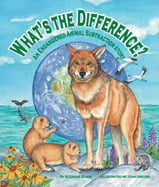Alignment to Standards for MT

| Grade | Number | Standard |
|---|---|---|
| 1 | S3.2.gr1.A. | Define herbivore and carnivore |
| 1 | S3.2.gr1.B. | Classify herbivore/carnivore |
| 1 | S3.2.gr1.C. | Define a food chain |
| 1 | S3.2.gr1.D. | Illustrate a food chain |
| 2 | S3.4.gr4.A. | Use a simple classification system for plants and animals characteristics, classify, classification system |
| 3 | S2.2.gr3.B. | Classify objects according to their physical properties. i.e., size, shape, color, texture, mass |
| 3 | S3.2.gr3.A. | Identify that from food, animals obtain energy and materials for body repair and growth. |
| 3 | S3.2.gr3.C. | how and why energy sources are needed to sustain life. |
| 3 | S3.4.gr3-4 | cause and effect relationships between nonliving and living components with ecosystems; and explain individual response to the changes in the environment including identifying differences between inherited, instinctual, and learned behaviors |
| 4 | S3.2.gr4.A. | Define producer, consumer, decomposer, food chain, food web. |
| 4 | S3.2.gr4.B. | Explain the difference between a food chain and a food web. |
| 4 | S3.2.gr4.C. | Illustrate and describe the relationships in food chains and food webs |
| 4 | S3.4.gr4.F. | Define predator, prey, competition |
| 4 | S3.4.gr4.G. | Identify examples of predator/prey relationships and competition |
| 4 | S3.5.grK-4. | Create and use a classification system to group a variety of plants and animals according to their similarities and differences |
| 4 | S3.5.grK-4.D. | Identify rules for classification |
| 4 | S3.5.grK-4.E. | Place organisms into groups according to the classification rules classify, similarities, differences, classification system |
| K | S3.5.grK B. | Group objects using a simple classification system |
| K-4 | S3.K-4 | characteristics, structures and function of living things, the process and diversity of life, and how living organisms interact with each other and their environment. |